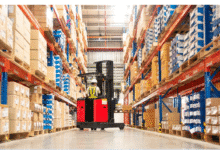Top 10 Warehouse Optimization Techniques Every Supply Chain Professional Should Master

Top 10 Warehouse Optimization Techniques Every Supply Chain Professional Should Master
Optimizing warehouse operations is crucial for supply chain efficiency, cost reduction, and customer satisfaction. In this post, we’ll break down ten essential warehouse optimization techniques—complete with examples and easy-to-follow Key Performance Indicator (KPI) calculation methods—to help you streamline your logistics and boost performance.
1. Recommended Storage Quantity (RSQ)
What is it?
RSQ is about determining the ideal inventory level at each stocking point by analyzing all supply chain parameters and constraints. This prevents excess inventory and defines what constitutes “waste.”
Example:
A company selling electronics determines, based on historical demand, supply lead time, and variability, that the optimal stock of smartphones at its main warehouse is 500 units.
KPI Calculation – Inventory Turnover:Inventory Turnover=Cost of Goods Sold (COGS)Average InventoryInventory Turnover=Average InventoryCost of Goods Sold (COGS)
- If COGS = $2,000,000 and Average Inventory = $500,000:
- Inventory Turnover = 4
2. ABC Analysis
What is it?
This technique prioritizes SKUs using Pareto principles, classifying them as A (high value), B (moderate value), or C (low value). It can focus on volume, sales value, or profit margin.
Example:
Warehouse stock:
- 5% of items contribute to 70% of sales (A)
- 15% contribute to 20% (B)
- 80% contribute to 10% (C)
KPI Calculation – % of Sales by Category:Percent SalesA=Sales of Category A ItemsTotal Sales×100Percent SalesA=Total SalesSales of Category A Items×100
- If Category A sales = $700,000 and total sales = $1,000,000: 70%
3. Cubic Space Utilization
What is it?
Measures how well the cubic (3D) warehouse space is used, not just floor area.
Example:
A warehouse has 10,000 m³ of available space, but uses only 6,000 m³ for actual storage.
KPI Calculation – Cubic Space Utilization Rate:Utilization=Used Cubic SpaceTotal Cubic Space×100Utilization=Total Cubic SpaceUsed Cubic Space×100
- Utilization = (6,000 / 10,000) × 100 = 60%
4. Concepting (Slotting)
What is it?
Deciding the right type (rack, bin, etc.) and location for each SKU, increasing cubic space use and workflow efficiency.
Example:
Fast-moving SKUs are slotted close to the picking area, while slow movers are farther away.
KPI Calculation – Picking Efficiency:
Number of orders picked per hour before and after proper slotting.
5. Dynamic Slotting
What is it?
Allocates product locations on-the-fly instead of fixed positions, adapting to current inventory and demand.
Example:
A returned product is slotted in the nearest available location based on real-time demand.
KPI Calculation – Putaway Efficiency:Average Putaway Time (minutes/item)Average Putaway Time (minutes/item)
6. Material Flow Optimization
What is it?
Designing product paths (I, U, L-type) and using tools like Spaghetti Diagram to prevent unnecessary movement and traffic jams.
Example:
Analyzing a flow reveals cross-traffic at the packing station, which is resolved by reconfiguring paths.
KPI Calculation – Throughput Time:Throughput Time=Total time from receipt to shipmentThroughput Time=Total time from receipt to shipment
Decreased time after optimization indicates improvement.
7. Gold Zone Management
What is it?
Placing the highest-velocity SKUs in the most accessible areas (“gold zones”) — near docks or at ground level.
Example:
Top sellers are placed at waist height near packing stations for faster picking.
KPI Calculation – Picking Productivity:Lines Picked per Labor HourLines Picked per Labor Hour
8. Pick Path Sequencing
What is it?
Optimizing the picker’s route through the warehouse to minimize walking distance, avoid backtracking and criss-crossing.
Example:
Implementing optimized pick paths saves 2 hours per shift per picker.
KPI Calculation – Average Picking Time per Order:Average Picking Time=Total Picking TimeNumber of OrdersAverage Picking Time=Number of OrdersTotal Picking Time
9. Material Handling Design
What is it?
Customizing equipment and methods based on warehouse processes to maximize productivity and ROI on machinery investments.
Example:
Introducing conveyor belts increases material handling equipment utilization to 80%.
KPI Calculation – Equipment Utilization Rate:Utilization=Actual Operating TimeTotal Available Time×100Utilization=Total Available TimeActual Operating Time×100
10. Warehouse Management System (WMS)
What is it?
Implementing software that controls inventory movement and storage, picking, putaway, and shipping.
Example:
Switching to a cloud-based WMS reduces order processing errors from 5% to 1%.
KPI Calculation – Order Accuracy Rate:Order Accuracy=Correct OrdersTotal Orders×100Order Accuracy=Total OrdersCorrect Orders×100






